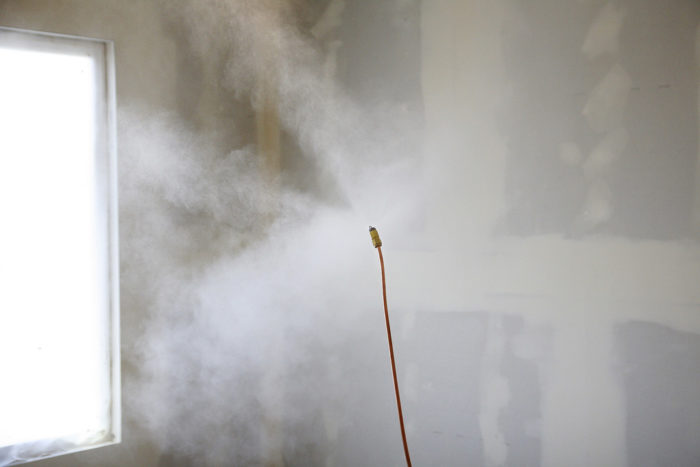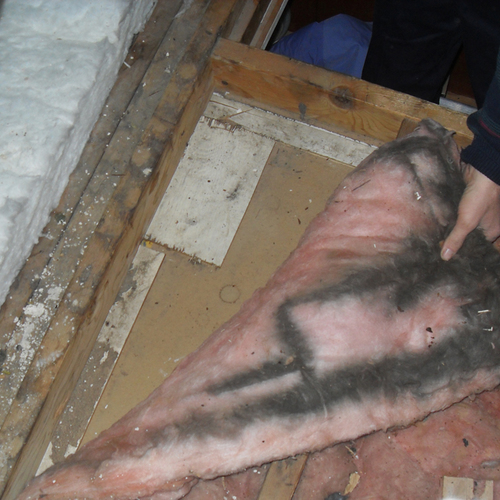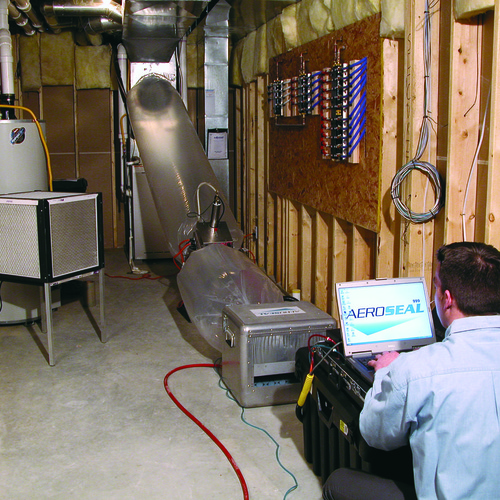Image Credit: Paul Fortunato / University of California at Davis
Image Credit: Paul Fortunato / University of California at Davis Sealing gaps without caulk. These gaps between electrical boxes and drywall were filled with a liquid sealant sprayed into a pressurized house.
Image Credit: Paul Fortunato / University of California at Davis
Builders who specialize in high-performance houses spend a lot of time tracking down and correcting air leaks. The process can involve a number of materials and sealants, such as special gaskets, tape, and caulk, plus a lot of time and attention to install them correctly.
Researchers at the Western Cooling Efficiency Center at the University of California-Davis think they’ve found a way to make the process much faster and easier.
According to an account by Daniel Mathews, this story started 16 years ago when Mark Modera, director of the university’s Western Cooling Efficiency Center, developed a duct-sealing procedure that was later marketed by a company called Aeroseal.
A fine mist of sealant forced under pressure into ducts gravitates toward leaks as it tries to escape and eventually plugs them up. Now Modera and other researchers are adapting the technology so it can be used to seal whole houses.
Cutting leakage by 50%
To treat an entire house, researchers place a nozzle at the center of each room and connect each one to a supply of liquid sealant. As the house is pressurized with a blower door fan, sealant is pumped out of the nozzle in the form of a fine mist, and air pressure carries it into wall and ceiling cavities to seal leaks.
The procedure has been tested on three Habitat for Humanity houses in California. “In these ‘already-sealed’ houses, it reduced leakage by about 50%,” Mathews said.
No one is inside the building during the procedure, so they won’t have to breathe in any of the sealing compound. Once the material has solidified, it’s considered non-toxic.
But Modera says the process is best suited for new houses or houses that are empty.
“We tried it in an existing home,” Modera told a reporter for The Record in Stockton, Calif. “I don’t feel comfortable thinking about doing it when there’s all the furniture in the house, but when someone moves out and you have an empty house, I think it will help.”
Treating occupied houses may be possible in the future, he told the paper, but it may be a year or two before the process is ready for commercial use even in new houses.
Lots of potential for the technology
Once fine-tuned, the process should substantially reduce the amount of time and effort builders spend on air-sealing a house with conventional tools and materials, says project manager Curtis Harrington, and potentially eliminate it completely. “In theory, we can seal any size hole,” he says. “It just takes longer.”
While the sealing is taking place, the blower door is providing “continuous feedback” on how tight the house is getting, Harrington says, and researchers now typically stop when they’ve run out of sealant. The process takes about two hours.
Researchers are currently experimenting with a modified version of a water-based acrylic sealant made by Tremco. Other sealants also will be tested.
How tight can the process make a house? Harrington says it should be possible to get blower-door results of 1 air change per hour at 50 pascals of pressure. That’s not a Passivhaus result, but it’s a very tight house.
Weekly Newsletter
Get building science and energy efficiency advice, plus special offers, in your inbox.
















2 Comments
I Love this approach
Whenever a process is developed that eliminates the need for skilled labor, it can be an impressive money-saver.
Testing a house for air leakage is easy. Finding and sealing all the leaks is not easy or cheap. Even when it's possible to seal the leaks, it can be hard to convince the decision makers to spend the money to do it.
An automated method like this could be the ultimate solution to this difficult problem.
So it's like ... fix-a-flat
So it's like ... fix-a-flat for a house. You definitely wouldn't
want to try this in an occupied/furnished or likely even
interior-finished building, though...
_H*
Log in or create an account to post a comment.
Sign up Log in